文化差异 提纲 经典例子
- 格式:doc
- 大小:40.50 KB
- 文档页数:3
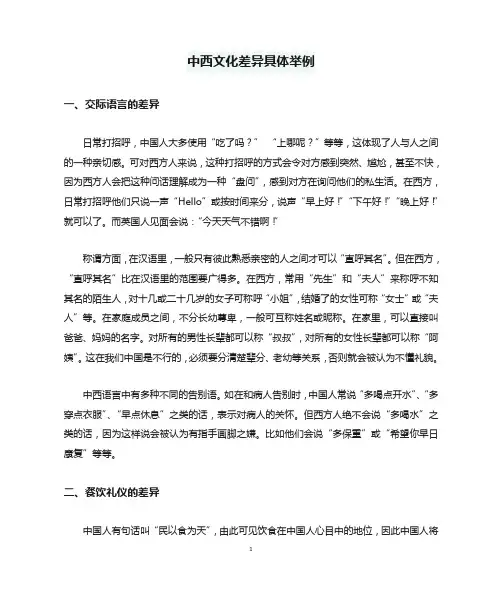
中西文化差异具体举例一、交际语言的差异日常打招呼,中国人大多使用“吃了吗?”“上哪呢?”等等,这体现了人与人之间的一种亲切感。
可对西方人来说,这种打招呼的方式会令对方感到突然、尴尬,甚至不快,因为西方人会把这种问话理解成为一种“盘问”,感到对方在询问他们的私生活。
在西方,日常打招呼他们只说一声“Hello”或按时间来分,说声“早上好!”“下午好!”“晚上好!”就可以了。
而英国人见面会说:“今天天气不错啊!”称谓方面,在汉语里,一般只有彼此熟悉亲密的人之间才可以“直呼其名”。
但在西方,“直呼其名”比在汉语里的范围要广得多。
在西方,常用“先生”和“夫人”来称呼不知其名的陌生人,对十几或二十几岁的女子可称呼“小姐”,结婚了的女性可称“女士”或“夫人”等。
在家庭成员之间,不分长幼尊卑,一般可互称姓名或昵称。
在家里,可以直接叫爸爸、妈妈的名字。
对所有的男性长辈都可以称“叔叔”,对所有的女性长辈都可以称“阿姨”。
这在我们中国是不行的,必须要分清楚辈分、老幼等关系,否则就会被认为不懂礼貌。
中西语言中有多种不同的告别语。
如在和病人告别时,中国人常说“多喝点开水”、“多穿点衣服”、“早点休息”之类的话,表示对病人的关怀。
但西方人绝不会说“多喝水”之类的话,因为这样说会被认为有指手画脚之嫌。
比如他们会说“多保重”或“希望你早日康复”等等。
二、餐饮礼仪的差异中国人有句话叫“民以食为天”,由此可见饮食在中国人心目中的地位,因此中国人将吃饭看作头等大事。
中国菜注重菜肴色、香、味、形、意俱全,甚至于超过了对营养的注重,只要好吃又要好看,营养反而显得不重要了。
西方的饮食比较讲究营养的搭配和吸收,是一种科学的饮食观念。
西方人多注重食物的营养而忽略了食物的色、香、味、形、意如何,他们的饮食多是为了生存和健康,似乎不讲究味的享受。
在餐饮氛围方面,中国人在吃饭的时候都喜欢热闹,很多人围在一起吃吃喝喝,说说笑笑,大家在一起营造一种热闹温暖的用餐氛围。
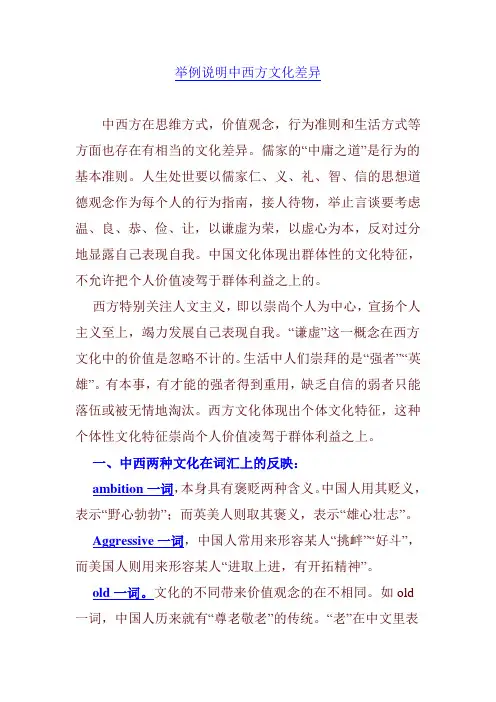
举例说明中西方文化差异中西方在思维方式,价值观念,行为准则和生活方式等方面也存在有相当的文化差异。
儒家的“中庸之道”是行为的基本准则。
人生处世要以儒家仁、义、礼、智、信的思想道德观念作为每个人的行为指南,接人待物,举止言谈要考虑温、良、恭、俭、让,以谦虚为荣,以虚心为本,反对过分地显露自己表现自我。
中国文化体现出群体性的文化特征,不允许把个人价值凌驾于群体利益之上的。
西方特别关注人文主义,即以崇尚个人为中心,宣扬个人主义至上,竭力发展自己表现自我。
“谦虚”这一概念在西方文化中的价值是忽略不计的。
生活中人们崇拜的是“强者”“英雄”。
有本事,有才能的强者得到重用,缺乏自信的弱者只能落伍或被无情地淘汰。
西方文化体现出个体文化特征,这种个体性文化特征崇尚个人价值凌驾于群体利益之上。
一、中西两种文化在词汇上的反映:ambition一词,本身具有褒贬两种含义。
中国人用其贬义,表示“野心勃勃”;而英美人则取其褒义,表示“雄心壮志”。
Aggressive一词,中国人常用来形容某人“挑衅”“好斗”,而美国人则用来形容某人“进取上进,有开拓精神”。
old一词。
文化的不同带来价值观念的在不相同。
如old 一词,中国人历来就有“尊老敬老”的传统。
“老”在中文里表达尊敬的概念,如老祖宗,老爷爷,老先生等。
“老张”,“老王”,透着尊敬和亲热,“张老”“王老”更是尊崇有加。
中国人往往以年龄大为荣。
和别人谈话时,年龄越大,资格越老,也就越会得到别人的尊敬。
“姜还是老的辣”。
在我们看来,长者不仅是智慧的化身,也是威望的象征。
西方国家极少有人愿意倚老卖老而自称”old”。
在他们看来,“old” 是“不中用”的代名词,是和“不合潮流”“老而无用”的含义连在一起的。
英美人不喜欢别人说自己老,更不会倚老卖老。
在西方文化中,他们把年龄作为个人极为重要的隐私看待。
尤其是女士,更忌讳别人问自己的年龄。
fat一词。
英美人忌讳莫深的fat一词,见人说fat会令人沮丧不快而且反感。
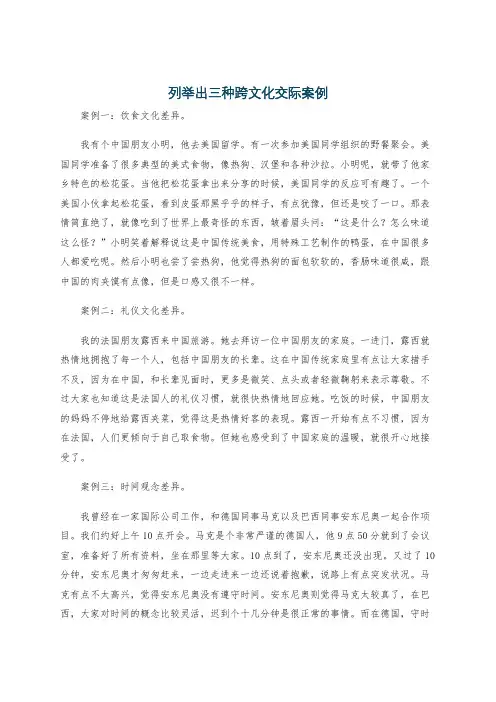
列举出三种跨文化交际案例案例一:饮食文化差异。
我有个中国朋友小明,他去美国留学。
有一次参加美国同学组织的野餐聚会。
美国同学准备了很多典型的美式食物,像热狗、汉堡和各种沙拉。
小明呢,就带了他家乡特色的松花蛋。
当他把松花蛋拿出来分享的时候,美国同学的反应可有趣了。
一个美国小伙拿起松花蛋,看到皮蛋那黑乎乎的样子,有点犹豫,但还是咬了一口。
那表情简直绝了,就像吃到了世界上最奇怪的东西,皱着眉头问:“这是什么?怎么味道这么怪?”小明笑着解释说这是中国传统美食,用特殊工艺制作的鸭蛋,在中国很多人都爱吃呢。
然后小明也尝了尝热狗,他觉得热狗的面包软软的,香肠味道很咸,跟中国的肉夹馍有点像,但是口感又很不一样。
案例二:礼仪文化差异。
我的法国朋友露西来中国旅游。
她去拜访一位中国朋友的家庭。
一进门,露西就热情地拥抱了每一个人,包括中国朋友的长辈。
这在中国传统家庭里有点让大家措手不及,因为在中国,和长辈见面时,更多是微笑、点头或者轻微鞠躬来表示尊敬。
不过大家也知道这是法国人的礼仪习惯,就很快热情地回应她。
吃饭的时候,中国朋友的妈妈不停地给露西夹菜,觉得这是热情好客的表现。
露西一开始有点不习惯,因为在法国,人们更倾向于自己取食物。
但她也感受到了中国家庭的温暖,就很开心地接受了。
案例三:时间观念差异。
我曾经在一家国际公司工作,和德国同事马克以及巴西同事安东尼奥一起合作项目。
我们约好上午10点开会。
马克是个非常严谨的德国人,他9点50分就到了会议室,准备好了所有资料,坐在那里等大家。
10点到了,安东尼奥还没出现。
又过了10分钟,安东尼奥才匆匆赶来,一边走进来一边还说着抱歉,说路上有点突发状况。
马克有点不太高兴,觉得安东尼奥没有遵守时间。
安东尼奥则觉得马克太较真了,在巴西,大家对时间的概念比较灵活,迟到个十几分钟是很正常的事情。
而在德国,守时是非常重要的品质。
最后我只好在中间打圆场,说大家不同的文化背景下时间观念确实有差别,但是为了项目顺利进行,还是要尽量协调好。
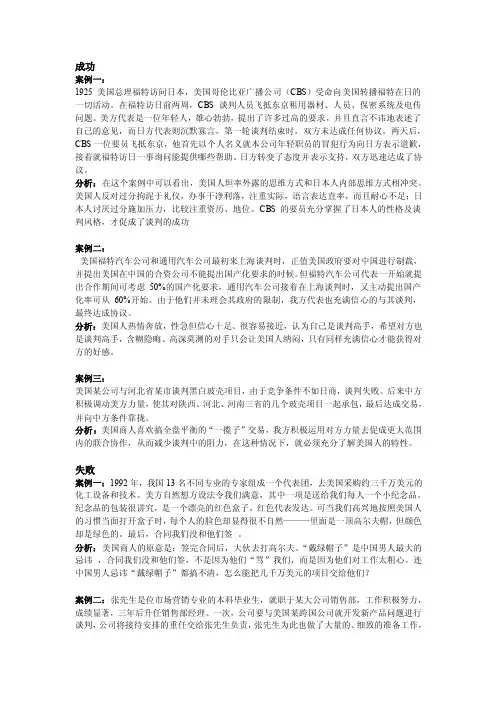
成功案例一:1925美国总理福特访问日本,美国哥伦比亚广播公司(CBS)受命向美国转播福特在日的一切活动。
在福特访日前两周,CBS谈判人员飞抵东京租用器材、人员、保密系统及电传问题。
美方代表是一位年轻人,雄心勃勃,提出了许多过高的要求,并且直言不讳地表述了自己的意见,而日方代表则沉默寡言,第一轮谈判结束时,双方未达成任何协议。
两天后,CBS一位要员飞抵东京,他首先以个人名义就本公司年轻职员的冒犯行为向日方表示道歉,接着就福特访日一事询问能提供哪些帮助。
日方转变了态度并表示支持,双方迅速达成了协议。
分析:在这个案例中可以看出,美国人坦率外露的思维方式和日本人内部思维方式相冲突。
美国人反对过分拘泥于礼仪,办事干净利落,注重实际,语言表达直率,而且耐心不足;日本人讨厌过分施加压力,比较注重资历、地位。
CBS的要员充分掌握了日本人的性格及谈判风格,才促成了谈判的成功案例二:美国福特汽车公司和通用汽车公司最初来上海谈判时,正值美国政府要对中国进行制裁,并提出美国在中国的合资公司不能提出国产化要求的时候。
但福特汽车公司代表一开始就提出合作期间可考虑50%的国产化要求,通用汽车公司接着在上海谈判时,又主动提出国产化率可从60%开始。
由于他们并未理会其政府的限制,我方代表也充满信心的与其谈判,最终达成协议。
分析:美国人热情奔放,性急但信心十足、很容易接近,认为自己是谈判高手,希望对方也是谈判高手,含糊隐晦、高深莫测的对手只会让美国人纳闷,只有同样充满信心才能获得对方的好感。
案例三:美国某公司与河北省某市谈判黑白玻壳项目,由于竞争条件不如日商,谈判失败。
后来中方积极调动美方力量,使其对陕西、河北、河南三省的几个玻壳项目一起承包,最后达成交易,并向中方条件靠拢。
分析:美国商人喜欢搞全盘平衡的“一揽子”交易,我方积极运用对方力量去促成更大范围内的联合协作,从而减少谈判中的阻力,在这种情况下,就必须充分了解美国人的特性。
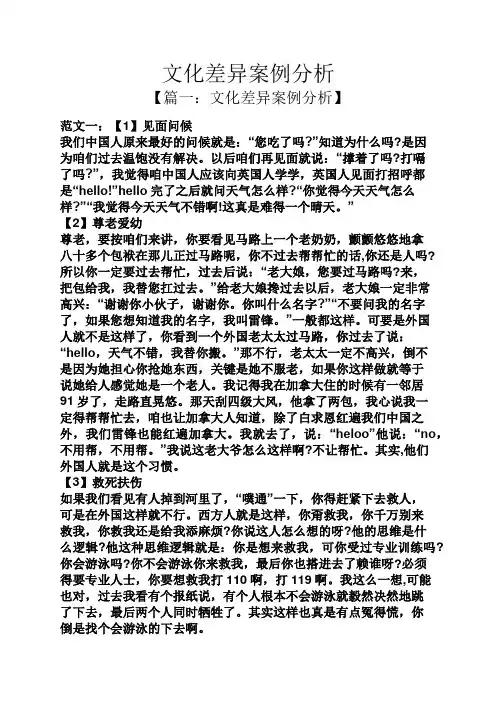
文化差异案例分析【篇一:文化差异案例分析】范文一:【1】见面问候我们中国人原来最好的问候就是:“您吃了吗?”知道为什么吗?是因为咱们过去温饱没有解决。
以后咱们再见面就说:“撑着了吗?打嗝了吗?”,我觉得咱中国人应该向英国人学学,英国人见面打招呼都是“hello!”hello完了之后就问天气怎么样?“你觉得今天天气怎么样?”“我觉得今天天气不错啊!这真是难得一个晴天。
”【2】尊老爱幼尊老,要按咱们来讲,你要看见马路上一个老奶奶,颤颤悠悠地拿八十多个包袱在那儿正过马路呢,你不过去帮帮忙的话,你还是人吗?所以你一定要过去帮忙,过去后说:“老大娘,您要过马路吗?来,把包给我,我替您扛过去。
”给老大娘搀过去以后,老大娘一定非常高兴:“谢谢你小伙子,谢谢你。
你叫什么名字?”“不要问我的名字了,如果您想知道我的名字,我叫雷锋。
”一般都这样。
可要是外国人就不是这样了,你看到一个外国老太太过马路,你过去了说:“hello,天气不错,我替你搬。
”那不行,老太太一定不高兴,倒不是因为她担心你抢她东西,关键是她不服老,如果你这样做就等于说她给人感觉她是一个老人。
我记得我在加拿大住的时候有一邻居91岁了,走路直晃悠。
那天刮四级大风,他拿了两包,我心说我一定得帮帮忙去,咱也让加拿大人知道,除了白求恩红遍我们中国之外,我们雷锋也能红遍加拿大。
我就去了,说:“heloo”他说:“no,不用帮,不用帮。
”我说这老大爷怎么这样啊?不让帮忙。
其实,他们外国人就是这个习惯。
【3】救死扶伤如果我们看见有人掉到河里了,“噗通”一下,你得赶紧下去救人,可是在外国这样就不行。
西方人就是这样,你甭救我,你千万别来救我,你救我还是给我添麻烦?你说这人怎么想的呀?他的思维是什么逻辑?他这种思维逻辑就是:你是想来救我,可你受过专业训练吗?你会游泳吗?你不会游泳你来救我,最后你也搭进去了赖谁呀?必须得要专业人士,你要想救我打110啊,打119啊。
我这么一想,可能也对,过去我看有个报纸说,有个人根本不会游泳就毅然决然地跳了下去,最后两个人同时牺牲了。
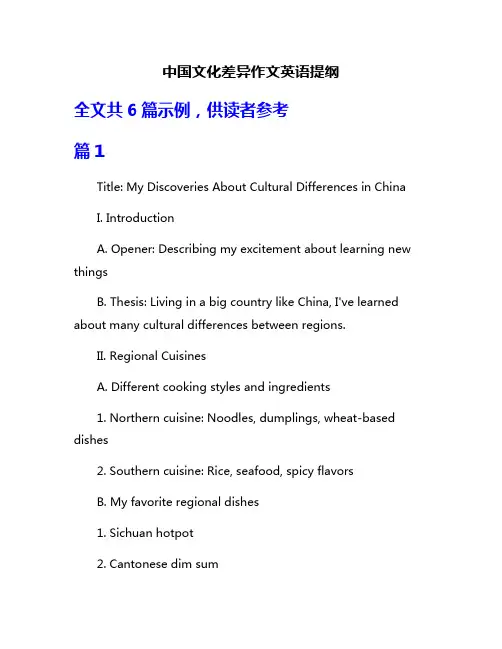
中国文化差异作文英语提纲全文共6篇示例,供读者参考篇1Title: My Discoveries About Cultural Differences in ChinaI. IntroductionA. Opener: Describing my excitement about learning new thingsB. Thesis: Living in a big country like China, I've learned about many cultural differences between regions.II. Regional CuisinesA. Different cooking styles and ingredients1. Northern cuisine: Noodles, dumplings, wheat-based dishes2. Southern cuisine: Rice, seafood, spicy flavorsB. My favorite regional dishes1. Sichuan hotpot2. Cantonese dim sumC. Trying new foods during family tripsIII. Languages and DialectsA. Mandarin as the official languageB. Diverse dialects across provinces1. Cantonese in Guangdong2. Shanghainese in ShanghaiC. Challenges of communicating with locals during travelsD. The fun of learning new words and phrasesIV. Traditional FestivalsA. Spring Festival (Chinese New Year)1. Family reunions2. Red envelopes and fireworksB. Mid-Autumn Festival1. Mooncakes and lanterns2. Legends and traditionsC. Regional variations in celebrating festivalsV. Architecture and LandscapesA. Historic buildings and landmarks1. Forbidden City in Beijing2. Terracotta Warriors in Xi'anB. Natural wonders1. Karst mountains in Guilin2. Beaches in HainanC. Appreciation for diverse architectural stylesVI. Arts and CraftsA. Pottery and porcelainB. Silk and embroideryC. Calligraphy and paintingD. Regional specialties and techniquesVII. ConclusionA. Summary of key cultural differencesB. The joy of embracing diversityC. Encouraging others to explore and appreciate culturesThis outline covers various aspects of cultural differences in China, such as cuisine, languages, festivals, architecture, and arts & crafts. It is written from a primary school student's perspective, with a mix of personal experiences and factual information. The tone is enthusiastic and inquisitive, reflecting a child's sense of wonder and curiosity about the diverse cultures within their country.篇2Title: My Experiences with Cultural Differences in ChinaIntroduction (150 words)Growing up in a diverse country like China, I've learned that people have many different cultures and customsEven within my own extended family, I've noticed differences in how my relatives live and what traditions they followThis makes China a fascinating place, with cultural diversity present even in my own city/townThesis: In this essay, I will share some of the cultural differences I've experienced between various groups in China, including differences in food, festivals, languages, and family values.Body Paragraph 1 (250 words)Describe differences in cuisine and food culture across different regions/ethnic groupsSpecific examples of dishes from different provincial cuisines (Sichuan, Cantonese, Hunan, etc.)Different dietary practices (Buddhist vegetarians, Muslim halal, etc.)Unique food customs (chopsticks vs hands, etiquette around dining, etc.)Explain how exposure to diverse foods has beeneye-opening and enrichingDiscuss a memorable experience trying a new dish or cuisine for the first timeBody Paragraph 2 (250 words)Describe observing various festivals and holidays celebrated by different culturesMajor holidays like Chinese New Year, but celebrated differently by ethnic groupsUnique festivals like Torch Festival (Yi people), Lusheng Festival (Miao people)Anecdotes of participating in friends'/relatives' cultural celebrationsExplain the importance of festivals in passing down traditionsDiscuss the diversity even within one's ownfamily/community celebrationsBody Paragraph 3 (250 words)Discuss the multilingual environment in ChinaMention prevalence of languages like Cantonese, Hokkien, Tibetan, Uyghur, MongolianChallenges/advantages of having classmates or neighbors who speak different home languagesThe experience of trying to learn simple phrases in other languagesExplain how language diversity has inspired curiosity and appreciation for other culturesDiscuss an experience of language barriers or miscommunication due to differencesBody Paragraph 4 (250 words)Describe differences in family values, structures, and traditions across culturesExtended vs nuclear families, roles of elders, raising children, etc.Examples of unique coming-of-age ceremonies or rites of passageContrasting attitudes around concepts like filial piety, gender roles, etc.Reflect on realizing that what seems "normal" is, in fact, culture-specificDiscuss learning about differing values from afriend/classmate of another backgroundConclusion (200 words)Reiterate how cultural diversity has been ever-present throughout your childhoodDiscuss the biggest lessons learned about respecting differences while finding common groundExplain how experiencing diversity has made you more open-minded and appreciativeThe importance of cultural exchange and understanding for ethnic harmony in ChinaFinal thoughts on continuing to explore China's rich cultural tapestryThis outline provides a comprehensive structure to write a 2000 word essay from a child's perspective on the cultural diversity within China. Let me know if you need any clarification or have additional requirements.篇3Title: My Observations on Cultural Differences in ChinaIntroduction (150 words)Myself - a curious elementary student who has had the chance to travel around ChinaFascination with the diversity of cultures and customs within one countryThesis: China is a vast land with many cultural differences between regions when it comes to languages, foods, traditions, and more.Body Paragraph 1: Languages (300 words)In China there are many dialects and languages beyond just Mandarin ChineseDescribe a few key ones like Cantonese, Shanghainese, and minority languagesGive examples of the different tones, sounds, writing systemsHow dialects vary even in nearby areasMy experiences trying to communicate in different tongues around ChinaBody Paragraph 2: Foods (400 words)Huge variations in cuisines and specialties across different provincesExamples: Sichuan cuisine with its spicy dishes, Cantonese dim sum, Beijing's flavorsInteresting regional ingredients like stinky tofu, century eggs, wontons, noodles, dumplingsMemorable dishes I tried on my travels and how they differed from my hometown foodsCustoms around meals like tea drinking, family-style sharing, etc.Body Paragraph 3: Traditions & Festivals (400 words)The diverse traditional celebrations and festivals in China's many culturesSpring Festival traditions I experienced: red envelopes, family reunions, dumplingsRegional holidays like the Dragon Boat Festival, Mid-Autumn Festival, LohriMinority cultural festivals of dance, music, dress like Tibetan New YearDifferences in beliefs, symbolic meanings, rituals between placesBody Paragraph 4: Architecture & Arts (300 words)The unique architecture and arts that developed in China's distinct cultural spheresRegional styles of temples, pagodas, houses like Hakka earth buildingsTraditional crafts like calligraphy, jade carving, embroidery varying by areaSeeing differences in museums, historic sites, art forms on my travelsConclusion (150 words)The richness of China's cultural diversity is fascinating to experienceWhat I learned from encountering the different languages, cuisines, traditions, artsDespite the many regional variations, an appreciation for China's long historyClosing thoughts on the importance of understanding cultural differencesThis gives a comprehensive outline touching on major aspects of cultural diversity within China, while keeping the tone appropriate for an elementary-level student's perspective andexperiences. The length targets around 2000 words total. Let me know if you would like me to modify or expand the outline further.篇4I. IntroductionA. Grabbing the reader's attention with a personal experience or anecdote about noticing cultural differencesB. Thesis statement: China is a vast country with a rich history and diverse cultures, leading to various cultural differences across regions.II. Geographical and Historical InfluencesA. China's vast geography and varying landscapes1. Different climates and natural resources across regions2. Impact on lifestyles, traditions, and cultural practicesB. China's long and eventful history1. Influence of dynasties, rulers, and historical events2. Cultural legacies and traditions passed down through generationsIII. Language and DialectsA. Mandarin as the official languageB. Diverse dialects and their unique characteristics1. Examples: Cantonese, Shanghainese, Fuzhounese, etc.2. Difficulties in communication across different dialect speakersIV. Cuisine and Eating TraditionsA. Regional cuisines and their distinctive flavors1. Examples: Sichuan, Cantonese, Hunan, Shandong, etc.2. Influence of geography, climate, and available ingredientsB. Eating customs and etiquette1. Use of chopsticks and proper table manners2. Sharing dishes and communal eatingV. Festivals and CelebrationsA. Traditional festivals with deep cultural roots1. Chinese New Year (Spring Festival)2. Mid-Autumn Festival3. Dragon Boat FestivalB. Regional variations in festival celebrations and customsVI. Arts and CraftsA. Traditional art forms and their regional origins1. Calligraphy2. Painting (landscapes, portraits, etc.)3. Pottery and porcelainB. Unique crafts and handicrafts across different regions1. Examples: Embroidery, woodcarving, jade carving, etc.VII. Architecture and LandscapesA. Traditional architectural styles and their regional influences1. Siheyuan (courtyard houses)2. Tulou (earthen buildings)3. Wooden architecture of ethnic minoritiesB. Famous landmarks and natural wonders across ChinaVIII. ConclusionA. Summarizing the cultural diversity of ChinaB. Emphasizing the importance of understanding and appreciating cultural differencesC. Personal reflection on the richness of Chinese cultureNote: This outline serves as a general guide, and each section should be expanded with relevant details, examples, and personal experiences or observations to create a well-rounded essay.篇5Title: My Experiences with Cultural Differences in ChinaIntroduction (150 words)Introduce myself as a young student in ChinaMention that China is a vast country with many diverse cultures and traditionsExplain that I have had the opportunity to experience some of these cultural differences firsthandThesis: In this essay, I will share my experiences and observations about three major cultural differences I have encountered in China.Differences in language and dialects across regionsExplain that China has many spoken languages and dialectsDescribe an experience of visiting a different region and struggling to communicateDiscuss the importance of learning the locallanguage/dialect to connect with peopleMention the efforts by the government to promote Mandarin as a common languageBody Paragraph 2 (400 words)Differences in cuisines and eating customsHighlight the diversity of Chinese cuisines (Cantonese, Sichuan, Hunan, etc.)Describe unique eating customs I've observed (e.g., slurping noodles, sharing dishes)Discuss the symbolic meanings of certain foods and dishes in different culturesShare a personal experience of trying a new cuisine and struggling with chopsticksDifferences in festivals and celebrationsExplain the significance of traditional festivals like Chinese New Year, Mid-Autumn FestivalDescribe unique customs and traditions associated with these festivalsDiscuss the blend of modern and traditional elements in contemporary celebrationsShare a memorable experience of celebrating a festival with family or friendsConclusion (250 words)Restate the main points about the cultural differences discussedEmphasize the importance of respecting and appreciating cultural diversityDiscuss how experiencing different cultures has broadened my perspectiveExpress my enthusiasm for continuing to learn about other cultures in China and beyondEnd with a concluding remark about the richness of cultural diversity in ChinaBy following this outline, the essay should be around 2000 words in length and provide a comprehensive exploration of cultural differences in China from the perspective of a young student. Let me know if you would like me to elaborate on any part of the outline or if you need any other assistance.篇6Title: Discovering the Wonders of Chinese CultureIntroduction (150 words)My name and a little bit about myself as a studentExpress curiosity and excitement about learning new things, especially different culturesThesis statement: China has a rich and fascinating culture with many unique traditions that are quite different from my own culture.Body Paragraph 1: Food (300 words)Describe some popular and interesting Chinese dishes (dumplings, noodles, dim sum, etc.)Discuss using chopsticks instead of forks and knivesMention different flavors, ingredients, and cooking methods compared to my culture's cuisinePersonal anecdote about trying a new Chinese dish for the first timeBody Paragraph 2: Language (300 words)Explain that Chinese has many dialects like Cantonese and MandarinDescribe the written Chinese characters and how they represent words/meaningsCompare to the alphabet used in EnglishMention tones and how changing tones can change meaningsPersonal experience trying to learn a few basic Chinese phrasesBody Paragraph 3: Celebrations (350 words)Discuss major Chinese holidays like Chinese New Year and Mid-Autumn FestivalDescribe fun traditions like firecrackers, lion dances, mooncakes, red envelopesCompare and contrast to holidays/celebrations in my own culturePersonal story about attending or participating in a Chinese celebrationBody Paragraph 4: Arts & History (350 words)Overview of ancient Chinese inventions like paper, printing, the compassDescribe traditional arts like calligraphy, painting, martial arts, tai chiMention famous historical figures or dynastiesDiscuss architectural wonders like the Great Wall, Forbidden City, Terra Cotta WarriorsPersonal impression of seeing Chinese art, architecture or learning the historyConclusion (150 words)Restate how fascinating and unique Chinese culture isDiscuss the value of learning about different culturesExpress desire to learn even more about China in the futureFinal concluding sentence about appreciating cultural diversityThis outline provides a structure with 4 body paragraphs covering key aspects of Chinese culture from a student's perspective: food, language, celebrations, and arts/history. Personal anecdotes are included to make it more engaging. Let me know if you would like me to modify or expand the outline further.。
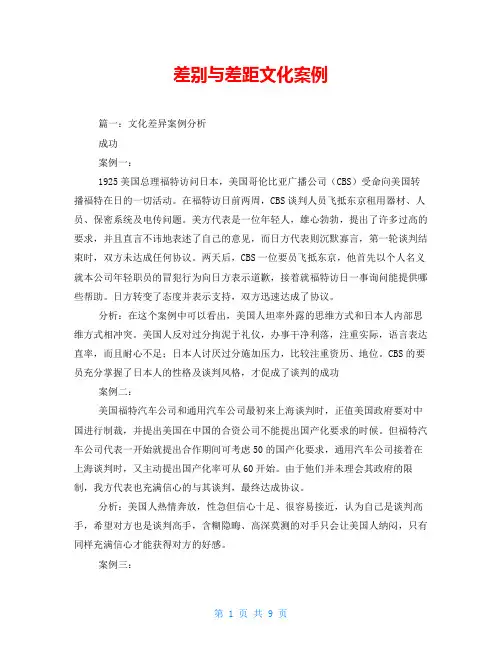
差别与差距文化案例篇一:文化差异案例分析成功案例一:1925美国总理福特访问日本,美国哥伦比亚广播公司(CBS)受命向美国转播福特在日的一切活动。
在福特访日前两周,CBS谈判人员飞抵东京租用器材、人员、保密系统及电传问题。
美方代表是一位年轻人,雄心勃勃,提出了许多过高的要求,并且直言不讳地表述了自己的意见,而日方代表则沉默寡言,第一轮谈判结束时,双方未达成任何协议。
两天后,CBS一位要员飞抵东京,他首先以个人名义就本公司年轻职员的冒犯行为向日方表示道歉,接着就福特访日一事询问能提供哪些帮助。
日方转变了态度并表示支持,双方迅速达成了协议。
分析:在这个案例中可以看出,美国人坦率外露的思维方式和日本人内部思维方式相冲突。
美国人反对过分拘泥于礼仪,办事干净利落,注重实际,语言表达直率,而且耐心不足;日本人讨厌过分施加压力,比较注重资历、地位。
CBS的要员充分掌握了日本人的性格及谈判风格,才促成了谈判的成功案例二:美国福特汽车公司和通用汽车公司最初来上海谈判时,正值美国政府要对中国进行制裁,并提出美国在中国的合资公司不能提出国产化要求的时候。
但福特汽车公司代表一开始就提出合作期间可考虑50的国产化要求,通用汽车公司接着在上海谈判时,又主动提出国产化率可从60开始。
由于他们并未理会其政府的限制,我方代表也充满信心的与其谈判,最终达成协议。
分析:美国人热情奔放,性急但信心十足、很容易接近,认为自己是谈判高手,希望对方也是谈判高手,含糊隐晦、高深莫测的对手只会让美国人纳闷,只有同样充满信心才能获得对方的好感。
案例三:美国某公司与河北省某市谈判黑白玻壳项目,由于竞争条件不如日商,谈判失败。
后来中方积极调动美方力量,使其对陕西、河北、河南三省的几个玻壳项目一起承包,最后达成交易,并向中方条件靠拢。
分析:美国商人喜欢搞全盘平衡的“一揽子”交易,我方积极运用对方力量去促成更大范围内的联合协作,从而减少谈判中的阻力,在这种情况下,就必须充分了解美国人的特性。
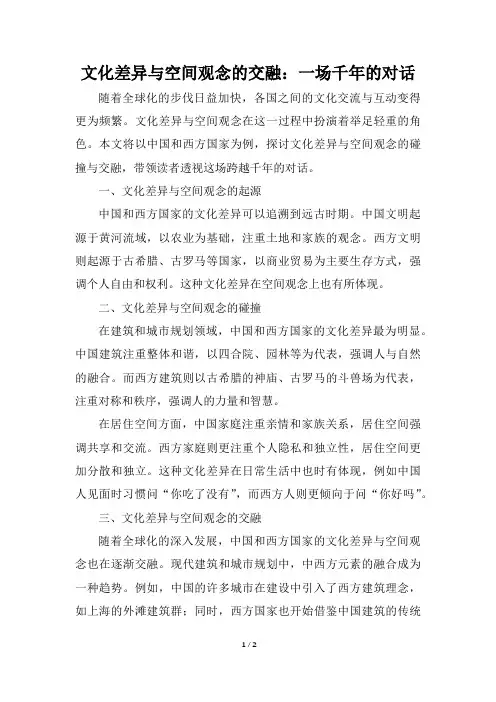
文化差异与空间观念的交融:一场千年的对话随着全球化的步伐日益加快,各国之间的文化交流与互动变得更为频繁。
文化差异与空间观念在这一过程中扮演着举足轻重的角色。
本文将以中国和西方国家为例,探讨文化差异与空间观念的碰撞与交融,带领读者透视这场跨越千年的对话。
一、文化差异与空间观念的起源中国和西方国家的文化差异可以追溯到远古时期。
中国文明起源于黄河流域,以农业为基础,注重土地和家族的观念。
西方文明则起源于古希腊、古罗马等国家,以商业贸易为主要生存方式,强调个人自由和权利。
这种文化差异在空间观念上也有所体现。
二、文化差异与空间观念的碰撞在建筑和城市规划领域,中国和西方国家的文化差异最为明显。
中国建筑注重整体和谐,以四合院、园林等为代表,强调人与自然的融合。
而西方建筑则以古希腊的神庙、古罗马的斗兽场为代表,注重对称和秩序,强调人的力量和智慧。
在居住空间方面,中国家庭注重亲情和家族关系,居住空间强调共享和交流。
西方家庭则更注重个人隐私和独立性,居住空间更加分散和独立。
这种文化差异在日常生活中也时有体现,例如中国人见面时习惯问“你吃了没有”,而西方人则更倾向于问“你好吗”。
三、文化差异与空间观念的交融随着全球化的深入发展,中国和西方国家的文化差异与空间观念也在逐渐交融。
现代建筑和城市规划中,中西方元素的融合成为一种趋势。
例如,中国的许多城市在建设中引入了西方建筑理念,如上海的外滩建筑群;同时,西方国家也开始借鉴中国建筑的传统元素,如意大利佛罗伦萨的“中国庭院”。
在居住空间方面,随着社会经济的发展和生活方式的改变,中西方家庭也在逐渐接受和融合不同的居住方式。
例如,越来越多的中国家庭开始注重个人隐私和独立性,而西方家庭则逐渐重视家庭成员之间的交流和共享空间。
四、文化差异与空间观念的未来趋势未来,随着科技的发展和全球化的深入推进,中西方文化差异与空间观念的交融将更加普遍。
数字化技术和互联网的应用将打破地域限制,为中西方文化交流提供更多机会。
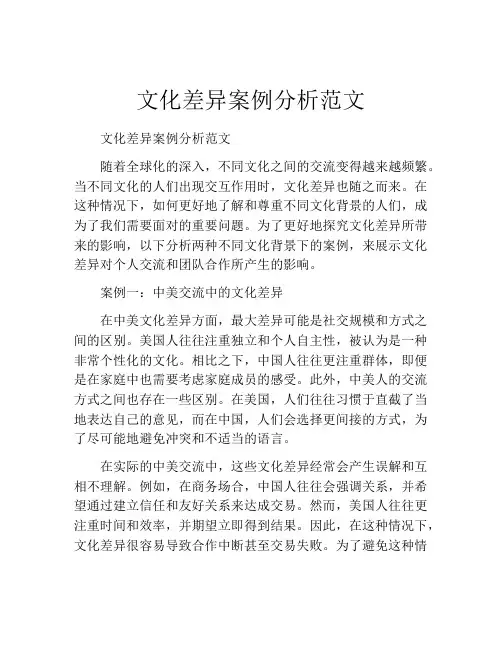
文化差异案例分析范文文化差异案例分析范文随着全球化的深入,不同文化之间的交流变得越来越频繁。
当不同文化的人们出现交互作用时,文化差异也随之而来。
在这种情况下,如何更好地了解和尊重不同文化背景的人们,成为了我们需要面对的重要问题。
为了更好地探究文化差异所带来的影响,以下分析两种不同文化背景下的案例,来展示文化差异对个人交流和团队合作所产生的影响。
案例一:中美交流中的文化差异在中美文化差异方面,最大差异可能是社交规模和方式之间的区别。
美国人往往注重独立和个人自主性,被认为是一种非常个性化的文化。
相比之下,中国人往往更注重群体,即便是在家庭中也需要考虑家庭成员的感受。
此外,中美人的交流方式之间也存在一些区别。
在美国,人们往往习惯于直截了当地表达自己的意见,而在中国,人们会选择更间接的方式,为了尽可能地避免冲突和不适当的语言。
在实际的中美交流中,这些文化差异经常会产生误解和互相不理解。
例如,在商务场合,中国人往往会强调关系,并希望通过建立信任和友好关系来达成交易。
然而,美国人往往更注重时间和效率,并期望立即得到结果。
因此,在这种情况下,文化差异很容易导致合作中断甚至交易失败。
为了避免这种情况的发生,双方需要了解彼此的文化背景和交流方式,并尝试在相互尊重和理解的基础上建立共识和合作。
案例二:跨国和本土团队之间的文化差异在全球化的时代,越来越多的公司和组织在世界范围内寻求业务机会。
这时,跨国和本土团队之间也会产生文化差异,这种差异可能会影响团队成员的相互理解和合作。
例如,一个跨国公司的美国团队和中国团队之间的文化差异会影响到员工的工作习惯、沟通风格和价值观。
在这种情况下,跨国公司需要采取一些措施来缓解文化差异所带来的负面影响。
首先,团队成员需要了解彼此的文化背景和行为方式,尊重彼此的差异,努力建立互相信任和合作。
其次,公司可以提供文化培训、交流活动和团队建设,以帮助员工更好地了解不同文化背景下的人们,并促进团队的合作和理解。
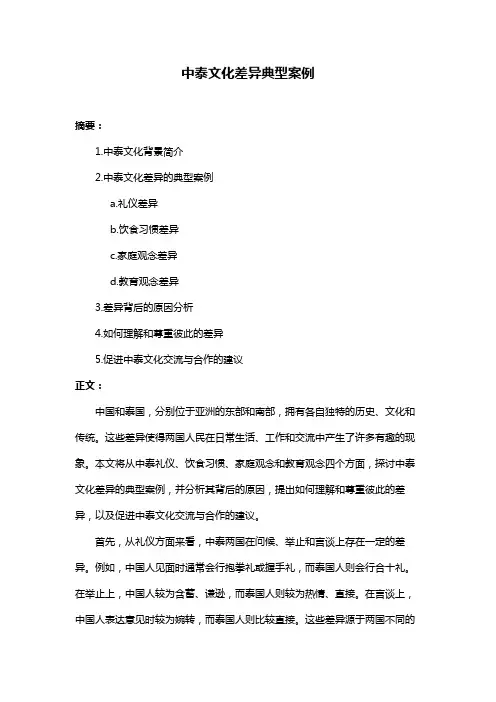
中泰文化差异典型案例摘要:1.中泰文化背景简介2.中泰文化差异的典型案例a.礼仪差异b.饮食习惯差异c.家庭观念差异d.教育观念差异3.差异背后的原因分析4.如何理解和尊重彼此的差异5.促进中泰文化交流与合作的建议正文:中国和泰国,分别位于亚洲的东部和南部,拥有各自独特的历史、文化和传统。
这些差异使得两国人民在日常生活、工作和交流中产生了许多有趣的现象。
本文将从中泰礼仪、饮食习惯、家庭观念和教育观念四个方面,探讨中泰文化差异的典型案例,并分析其背后的原因,提出如何理解和尊重彼此的差异,以及促进中泰文化交流与合作的建议。
首先,从礼仪方面来看,中泰两国在问候、举止和言谈上存在一定的差异。
例如,中国人见面时通常会行抱拳礼或握手礼,而泰国人则会行合十礼。
在举止上,中国人较为含蓄、谦逊,而泰国人则较为热情、直接。
在言谈上,中国人表达意见时较为婉转,而泰国人则比较直接。
这些差异源于两国不同的历史背景和传统价值观。
其次,饮食习惯的差异也是中泰文化的一个显著特点。
中国人讲究“民以食为天”,饮食文化丰富多样,注重烹饪技巧和食材搭配。
而泰国饮食以酸辣为主,注重香料和调料的使用,色香味俱佳。
中泰两国在食材、口味和烹饪方式上的差异,反映了两国地理环境、气候和农业资源的差异。
再者,家庭观念的差异在中泰文化中也有所体现。
在中国传统观念中,家庭观念较为浓厚,尊老爱幼、孝顺父母是中华民族的优良传统。
而在泰国,虽然也重视家庭,但家庭成员之间的独立性较强,相对而言,家庭观念较为宽松。
这种差异源于两国不同的历史背景和宗教信仰。
最后,教育观念的差异也值得关注。
中国的教育观念较为重视考试成绩和升学率,注重学生的基本功和实践能力。
而泰国教育更注重培养学生的创造力和思维能力,强调个性和兴趣的培养。
这种差异反映了两国对于教育目标的设定和实现方式的差异。
在理解和尊重彼此的差异方面,中泰两国人民需要加强相互了解和沟通,摒弃成见和偏见,尊重对方的文化传统和习俗。
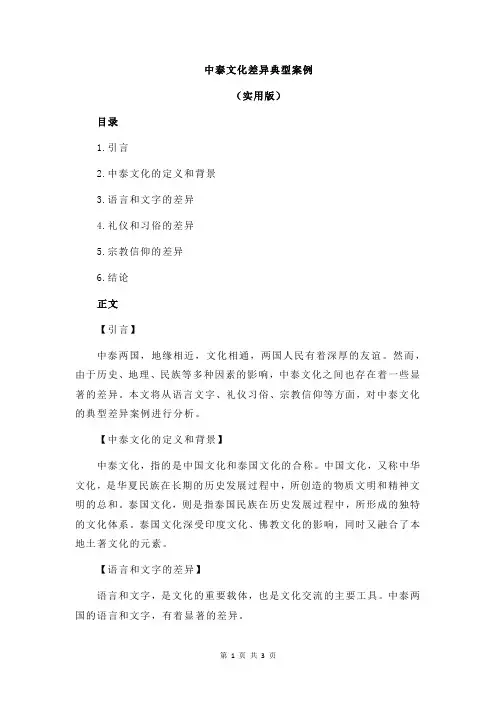
中泰文化差异典型案例(实用版)目录1.引言2.中泰文化的定义和背景3.语言和文字的差异4.礼仪和习俗的差异5.宗教信仰的差异6.结论正文【引言】中泰两国,地缘相近,文化相通,两国人民有着深厚的友谊。
然而,由于历史、地理、民族等多种因素的影响,中泰文化之间也存在着一些显著的差异。
本文将从语言文字、礼仪习俗、宗教信仰等方面,对中泰文化的典型差异案例进行分析。
【中泰文化的定义和背景】中泰文化,指的是中国文化和泰国文化的合称。
中国文化,又称中华文化,是华夏民族在长期的历史发展过程中,所创造的物质文明和精神文明的总和。
泰国文化,则是指泰国民族在历史发展过程中,所形成的独特的文化体系。
泰国文化深受印度文化、佛教文化的影响,同时又融合了本地土著文化的元素。
【语言和文字的差异】语言和文字,是文化的重要载体,也是文化交流的主要工具。
中泰两国的语言和文字,有着显著的差异。
汉语,是汉语族的语言,是世界上使用人数最多的语系之一。
泰语,属于汉藏语系,是泰国的官方语言。
两者在语音、语法、词汇等方面,都有着显著的差异。
中文,又称汉字,是中华文化的重要组成部分。
泰文,又称泰语,是泰国文化的重要组成部分。
两者在字形、字义、书写方式等方面,都有着显著的差异。
【礼仪和习俗的差异】礼仪和习俗,是文化的重要组成部分,也是文化交流的重要内容。
中泰两国的礼仪和习俗,有着显著的差异。
中国的礼仪,强调尊敬长辈,尊重师长,注重社会秩序。
泰国的礼仪,强调尊敬国王,尊重佛教,注重家庭和谐。
中国的习俗,注重春节、中秋节等传统节日,喜欢吃饺子、月饼等传统食物,喜欢喝绿茶、白酒等传统饮料。
泰国的习俗,注重水灯节、宋干节等传统节日,喜欢吃辣椒、糯米等传统食物,喜欢喝椰子水、红茶等传统饮料。
【宗教信仰的差异】宗教信仰,是文化的重要组成部分,也是文化交流的重要内容。
中泰两国的宗教信仰,有着显著的差异。
中国,是一个多元文化的国家,主要的宗教信仰有道教、佛教、伊斯兰教等。
生活中文化差异的例子50字
1、饮食方面:西方人的早餐和晚餐更偏向于冷食;中国人则习惯一日三餐吃热食或者是熟食。
2、人际关系方面:西方人与人关系分明,习惯AA制;中国人讲仁义,喜欢请客买单。
3、生活方面:西方的生活倾向于独立生活;中国人自古就是集体生活。
4、服饰方面:西方男士在正式社交场合通常穿保守式样的西装,内穿白衬衫,打领带通常穿黑色的皮鞋,西方女士在正式场合要穿礼服套装;虽中国人穿着打扮日趋西化,也会看到不少人穿着背心、短裤、拖鞋等西方认为不合礼仪的服饰。
5、教育方面:中国教育,大多是一种封闭教育,得遵守校规;西方教育完全是一种开拓自由思维的空间,他们是在玩中学习,在学习中思考。
中国文化差异的例子中国文化是世界上最古老的文化之一,拥有各种独特的传统和习惯。
中国与西方文化有很多差异。
以下是一些中西文化的差异。
礼仪在中国文化中,尊重长者和领导是非常重要的。
在面对上级或长辈时,我们通常会弯腰鞠躬,表示尊重。
我们认为,这种尊重可以带来好运和成功。
相反,在西方文化中,人们通常用握手表示欢迎和问候。
握手通常是很简单的,没有特别的含义。
用餐习惯中国和西方文化在饮食习惯方面也有很多差异。
中国的餐桌上,通常会放置一个大碗和一把大勺,用来共享主菜。
而西方人通常有自己的碗和餐具,每个人都有自己的主菜。
在中国文化中,餐桌上通常有许多菜肴,而在西方文化中,通常会选择几个菜肴,包括主菜和一些小菜。
面对挑战在中国文化中,人们通常希望避免冲突和争吵,因为我们认为这会损害人际关系和尊重。
而在西方文化中,人们通常更加直接,不怕提出自己的想法和建议。
当面对一个挑战时,在中国文化中,人们通常会试图达成共识,而在西方文化中,人们可能会尽力展现自己的优势和力量,以求取胜。
生活态度中国文化非常重视家庭和家人,认为家庭是最重要的。
在中国,通常会有多代人住在一个家庭中。
这种生活方式使得家人之间的联系更加紧密。
而在西方文化中,通常会选择单独居住,家庭成员数量较少。
身体语言在中国文化中,身体语言也是非常重要的。
比如,当我们想在谈话中表达谦虚时,我们会将手放在胸前,低头。
当我们表示不同意时,我们可能会张嘴,同时抬起手指。
这些行为在西方文化中是不常见的,但却非常常见在中国文化中。
总的来说,中国文化与西方文化之间存在很多差异。
这些差异影响着人们在不同情况下的行为和时间表达。
对于不同文化之间的差异,我们需要保持敏感并尊重。
Difference on Table Manners Between China and English—speakingCountriesZhou Yiqian(周益倩)The School of Aerospace, HIT, P.R.China(中国哈尔滨工业大学航天学院)AbstractIn this paper, we can find out the differences on table manners between China and English—Speaking countries. Generally speaking, Chinese table manners are rather informal, while on the contrary, some English—Speaking countries may have stick rules about table manners. The main purpose of this paper is to show the readers some detailed aspects of differences on table manners between China and English—Speaking countries. Through analyzing and comparing, we will have a better understanding of Chinese table manners as well as the table manners in some English—Speaking countries.Key Words: table manners, comparing, differences, understandingOutline1.Title(Thesis)Differences on Table Manners Between China and English—Speaking countries2.Question(Topic Sentence)A. In which aspect do table manners in China and some English--Speaking countries differ from each other?B. How do all these happen?3. Analysis and ContrastA: There are three main aspects:1. 1.Differences on table layout and tools served on the table.2. 2.The atmosphere on the table.3. 3.General behavior on the table.B: Some details to keep in mind.4. Solution5. ConclusionAll in all, the world’s cultures are equal. As with different cultures, we should be tolerant, as every kind of culture has their own value which can’t be measured by the same standard. At the same time, we should avoid blindly following. After all, we have our own culture and we should stick to the traditions.6. Bibliography (Reference Books or other sources)李晓莹,2006,中西方餐桌文化差异,.社会与文化4班周益倩Analysis of Different Cultures in the USA and the UK(四号字)Zhu Geili(祝给力)The School of Computer Science and Technology,HIT,P.R. China(中国哈尔滨工业大学计算机科学与技术学院)Abstract(小四号字)In this paper, we can find out there are still cultural differences between the two countries though they share the same language. The UK has a long history, and the USA has short and colorful history but they have multiple histories and may even include influences from other cultures. In fact, the USA is the mixture of all kinds of cultures. The main purpose of the paper is to show the readers the detailed aspects of each country and get a better understanding of each culture, especially the UK, the older and most typical one, and the USA, the younger and most dynamic one. Through analyzing and comparing or contrasting with the culture of China, we will have a better understanding of each culture and can improve our insight and enhance the awareness of cross-cultural communication.Key Words:cultural differences,influence,understanding,awarenessOutline(小四号字)I. Title (Thesis) Analysis of Different Cultures in the USA and the UKII. Question (Topic Sentence)A. What are the differences between the two countries in the aspect of culture?B. What is the relationship between the UK and the USA? Why are they special?III. Analysis and ContrastA. The differences among the two countries in the aspect of culture.1. The histories and social conditions of the countries.2. The phenomena that different countries have developed different social lives.B. The two typical countries and their relationships.1. Detailed Analysis and Contrast between the USA and the UK.2. The relationships between the two countries.IV. SolutionA. Explain the differences through the analysis and find out why the differences exist.B. Describe their relationships and conflicts of the two countries.C. The relationships and cooperation between China and the two countries.V. ConclusionAs time goes by, they have overcome all the obstacles and succeeded in building their totally new societies. Compared with them, our country has similar experience but still there exists differences. In this paper, I hope the readers can learn some cultural knowledge and improve their insights and enhance the awareness of cross-cultural communication.VI. Bibliography (Reference Books or other sources)Zhang Xuejun. 2011. A Brief Introduction to the Society and Culture of Major English-Speaking Countries. Harbin: Textbook self-compiledJohn Smith. 2010. Analysis of the Cultural Impact. Magazine or else. Davis, L. 2001. Doing Culture—Cross-cultural Communication in Action. Beijing: Foreign Language Teaching and Research Press.文秋芳,1996,《英语学习策略论》。
上海:上海外语教育出版社文秋芳,1998,英语成功者与不成功者在学习方法上的差异,《外语教学与研究》第3期。